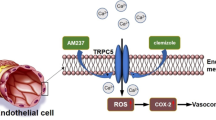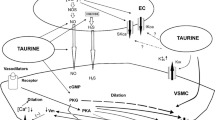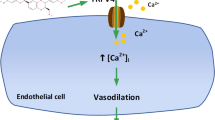Abstract
High dietary salt-caused hypertension is associated with increasing reactive oxygen species generation and reduced nitric oxide (NO) bioavailability. Transient receptor potential vanilloid type 1 (TRPV1), a specific receptor for capsaicin, is proposed to be involved in Dahl salt-sensitive hypertension, as determined in acute or short-term experiments. However, it remains unknown whether activation of TRPV1 by dietary capsaicin could prevent the vascular oxidative stress and hypertension induced by a high-salt diet. Here, we report that consumption of a high-salt diet blunted endothelium-dependent relaxation in mesenteric resistance arteries and elevated nocturnal blood pressure in mice. These effects were associated with increased superoxide anion generation and reduced NO levels in mesenteric vessels in mice on a high-salt diet. However, chronic administration of capsaicin reduced the high-salt diet-induced endothelial dysfunction and nocturnal hypertension in part by preventing the generation of superoxide anions and NO reduction of mesenteric arteries through vascular TRPV1 activation. Our findings provide new insights into the role of TRPV1 channels in the long-term regulation of blood pressure in response to high-salt intake. TRPV1 activation through chronic dietary capsaicin may represent a promising lifestyle intervention in populations with salt-sensitive hypertension.





Similar content being viewed by others
References
Anandakumar P, Kamaraj S, Jagan S et al (2008) Capsaicin modulates pulmonary antioxidant defense system during benzo(a)pyrene-induced lung cancer in Swiss albino mice. Phytother Res 22:529–533
Banday AA, Muhammad AB, Fazili FR et al (2007) Mechanisms of oxidative stress-induced increase in salt sensitivity and development of hypertension in Sprague-Dawley rats. Hypertension 49:664–671
Bo H, Jiang N, Ma G et al (2008) Regulation of mitochondrial uncoupling respiration during exercise in rat heart: role of reactive oxygen species (ROS) and uncoupling protein 2. Free Radic Biol Med 44:1373–1381
Cai H (2005) Hydrogen peroxide regulation of endothelial function: origins, mechanisms, and consequences. Cardiovasc Res 68:26–36
Caterina MJ, Schumacher MA, Tominaga M et al (1997) The capsaicin receptor: a heat-activated ion channel in the pain pathway. Nature 389:816–824
Cook NR, Cutler JA, Obarzanek E et al (2007) Long term effects of dietary sodium reduction on cardiovascular disease outcomes: observational follow-up of the trials of hypertension prevention (TOHP). BMJ 334:885–888
Crofton JT, Share L, Wang BC et al (1980) Pressor responsiveness to vasopressin in the rat with DOC-salt hypertension. Hypertension 2:424–431
Datla SR, Griendling KK (2010) Reactive oxygen species, NADPH oxidases, and hypertension. Hypertension 56:325–330
Del Rio D, Stewart AJ, Pellegrini N (2005) A review of recent studies on malondialdehyde as toxic molecule and biological marker of oxidative stress. Nutr Metab Cardiovasc Dis 15:316–328
Draper HH, Hadley M (1990) Malondialdehyde determination as index of lipid peroxidation. Methods Enzymol 186:421–431
Ettarh RR, Odigie IP, Adigun SA (2002) Vitamin C lowers blood pressure and alters vascular responsiveness in salt-induced hypertension. Can J Physiol Pharmacol 80:1199–1202
Farah V, Elased KM, Chen Y et al (2006) Nocturnal hypertension in mice consuming a high fructose diet. Auton Neurosci 130:41–50
Forstermann U (2010) Nitric oxide and oxidative stress in vascular disease. Pflugers Arch 459:923–939
Fujii T, Uzu T, Nishimura M et al (1999) Circadian rhythm of natriuresis is disturbed in nondipper type of essential hypertension. Am J Kidney Dis 33:29–35
Fujita M, Ando K, Nagae A et al (2007) Sympathoexcitation by oxidative stress in the brain mediates arterial pressure elevation in salt-sensitive hypertension. Hypertension 50:360–367
Fungers A, Kaiser K, Martini P (1958) Relation of essential hypertension to sodium chloride. I. Clinical & experimental animal experiments on the dependence of high blood pressure in essential hypertension on the quantity of sodium chloride; salt water hypertension in rats. Dtsch Arch Klin Med 204:603–623
Ibi M, Matsuno K, Shiba D et al (2008) Reactive oxygen species derived from NOX1/NADPH oxidase enhance inflammatory pain. J Neurosci 28:9486–9494
Intersalt Cooperative Research Group (1988) Intersalt: an international study of electrolyte excretion and blood pressure. Results for 24 hour urinary sodium and potassium excretion. BMJ 297:319–328
Joe B, Lokesh BR (1994) Role of capsaicin, curcumin and dietary n-3 fatty acids in lowering the generation of reactive oxygen species in rat peritoneal macrophages. Biochim Biophys Acta 1224:255–263
Kempaiah RK, Srinivasan K (2004) Influence of dietary curcumin, capsaicin and garlic on the antioxidant status of red blood cells and the liver in high-fat-fed rats. Ann Nutr Metab 48:314–320
Lee CY, Kim M, Yoon SW et al (2003) Short-term control of capsaicin on blood and oxidative stress of rats in vivo. Phytother Res 17:454–458
Luqman S, Rizvi SI (2006) Protection of lipid peroxidation and carbonyl formation in proteins by capsaicin in human erythrocytes subjected to oxidative stress. Phytother Res 20:303–306
Ma S, Ma L, Yang D et al (2010) Uncoupling protein 2 ablation exacerbates high-salt intake-induced vascular dysfunction. Am J Hypertens 23:822–828
McBryde FD, Malpas SC, Guild SJ et al (2009) A high-salt diet does not influence renal sympathetic nerve activity: a direct telemetric investigation. Am J Physiol Regul Integr Comp Physiol 297:R396–R402
Meng S, Cason GW, Gannon AW et al (2003) Oxidative stress in Dahl salt-sensitive hypertension. Hypertension 41:1346–1352
Miyamoto T, Dubin AE, Petrus MJ et al (2009) TRPV1 and TRPA1 mediate peripheral nitric oxide-induced nociception in mice. PLoS ONE 4:e7596
Nishio K, Qiao S, Yamashita H (2005) Characterization of the differential expression of uncoupling protein 2 and ROS production in differentiated mouse macrophage-cells (Mm1) and the progenitor cells (M1). J Mol Histol 36:35–44
Nurkiewicz TR, Boegehold MA (2007) High salt intake reduces endothelium-dependent dilation of mouse arterioles via superoxide anion generated from nitric oxide synthase. Am J Physiol Regul Integr Comp Physiol 292:R1550–R1556
Penner SB, Campbell NR, Chockalingam A et al (2007) Dietary sodium and cardiovascular outcomes: a rational approach. Can J Cardiol 23:567–572
Sharif Naeini R, Witty MF, Seguela P et al (2006) An N-terminal variant of Trpv1 channel is required for osmosensory transduction. Nat Neurosci 9:93–98
Song WZ, Chen AF, Wang DH (2004) Increased salt sensitivity induced by sensory denervation: role of superoxide. Acta Pharmacol Sin 25:1626–1632
Soundararajan R, Pearce D, Hughey RP et al (2010) Role of epithelial sodium channels and their regulators in hypertension. J Biol Chem 285:30363–30369
Tajima Y, Ichikawa S, Sakamaki T et al (1983) Body fluid distribution in the maintenance of DOCA-salt hypertension in rats. Am J Physiol 244:H695–H700
Taylor NE, Glocka P, Liang M et al (2006) NADPH oxidase in the renal medulla causes oxidative stress and contributes to salt-sensitive hypertension in Dahl S rats. Hypertension 47:692–698
Tian W, Fu Y, Wang DH et al (2006) Regulation of TRPV1 by a novel renally expressed rat TRPV1 splice variant. Am J Physiol-Renal 290:F117–F126
Touyz RM, Schiffrin EL (2004) Reactive oxygen species in vascular biology: implications in hypertension. Histochem Cell Biol 122:339–352
Uzu T, Kazembe FS, Ishikawa K et al (1996) High sodium sensitivity implicates nocturnal hypertension in essential hypertension. Hypertension 28:139–142
Uzu T, Kimura G, Yamauchi A et al (2006) Enhanced sodium sensitivity and disturbed circadian rhythm of blood pressure in essential hypertension. J Hypertens 24:1627–1632
Uzu T, Sakaguchi M, Yokomaku Y et al (2009) Effects of high sodium intake and diuretics on the circadian rhythm of blood pressure in type 2 diabetic patients treated with an angiotensin II receptor blocker. Clin Exp Nephrol 13:300–306
Wang Y, Chen AF, Wang DH (2006) Enhanced oxidative stress in kidneys of salt-sensitive hypertension: role of sensory nerves. Am J Physiol Heart Circ Physiol 291:H3136–H3143
Wang Y, Wang DH (2006) A novel mechanism contributing to development of Dahl salt-sensitive hypertension: role of the transient receptor potential vanilloid type 1. Hypertension 47:609–614
Watanabe E, Hiyama TY, Shimizu H et al (2006) Sodium-level-sensitive sodium channel Na(x) is expressed in glial laminate processes in the sensory circumventricular organs. Am J Physiol Regul Integr Comp Physiol 290:R568–R576
Wind S, Beuerlein K, Armitage ME et al (2010) Oxidative stress and endothelial dysfunction in aortas of aged spontaneously hypertensive rats by NOX1/2 is reversed by NADPH oxidase inhibition. Hypertension 56:490–497
Yang D, Luo Z, Ma S et al (2010) Activation of TRPV1 by dietary capsaicin improves endothelium-dependent vasorelaxation and prevents hypertension. Cell Metab 12:130–141
Yoshida T, Inoue R, Morii T et al (2006) Nitric oxide activates TRP channels by cysteine S-nitrosylation. Nat Chem Biol 2:596–607
Zhu J, Huang T, Lombard JH (2007) Effect of high-salt diet on vascular relaxation and oxidative stress in mesenteric resistance arteries. J Vasc Res 44:382–390
Zhu Y, Wang DH (2008) Segmental regulation of sodium and water excretion by TRPV1 activation in the kidney. J Cardiovasc Pharmacol 51:437–442
Zhu Y, Wang Y, Wang DH (2005) Diuresis and natriuresis caused by activation of VR1-positive sensory nerves in renal pelvis of rats. Hypertension 46:992–997
Acknowledgments
We thank Lijuan Wang (Chongqing Institute of Hypertension, China) for technical assistance. This research was supported by grants from the National Natural Science Foundation of China (30890042) and the National Basic Research Program of China (2011CB503902).
Conflict of interest
The authors declare that no conflict of interest exists.
Author information
Authors and Affiliations
Corresponding author
Additional information
Xinzhong Hao and Jing Chen contribute equally to this work.
Rights and permissions
About this article
Cite this article
Hao, X., Chen, J., Luo, Z. et al. TRPV1 activation prevents high-salt diet-induced nocturnal hypertension in mice. Pflugers Arch - Eur J Physiol 461, 345–353 (2011). https://doi.org/10.1007/s00424-011-0921-x
Received:
Revised:
Accepted:
Published:
Issue Date:
DOI: https://doi.org/10.1007/s00424-011-0921-x




